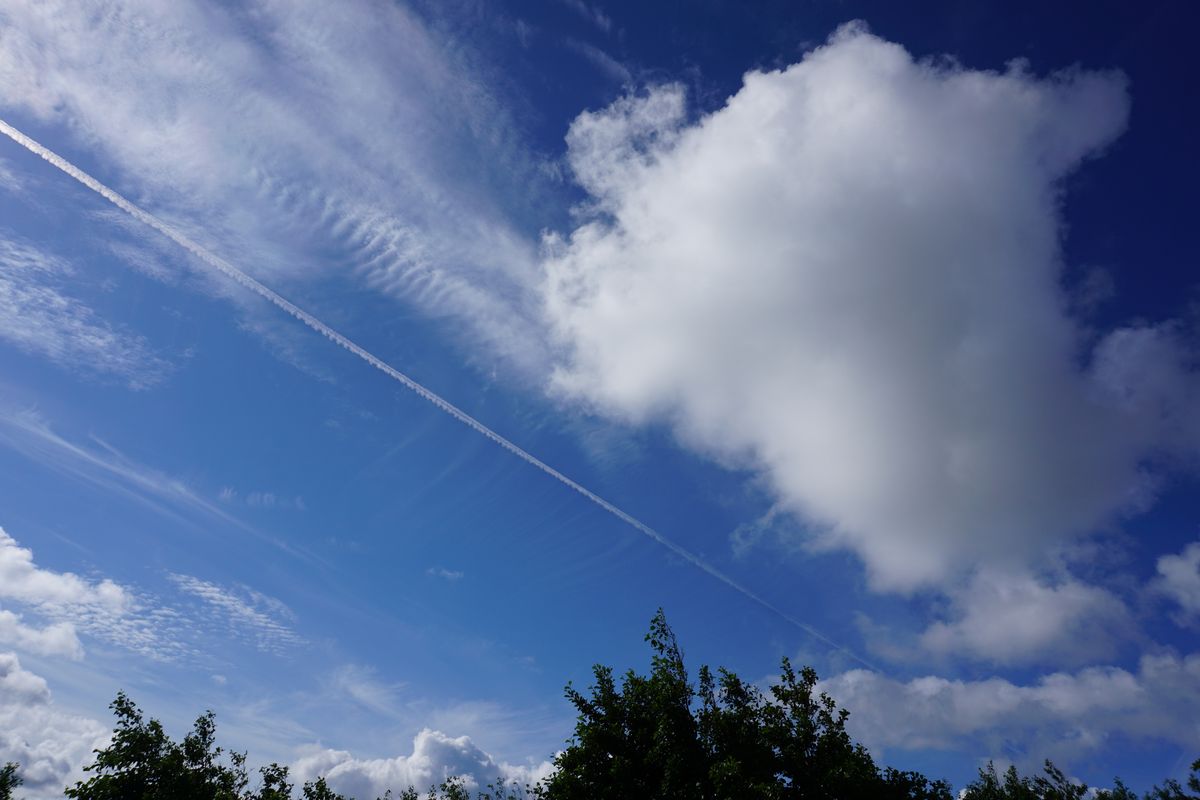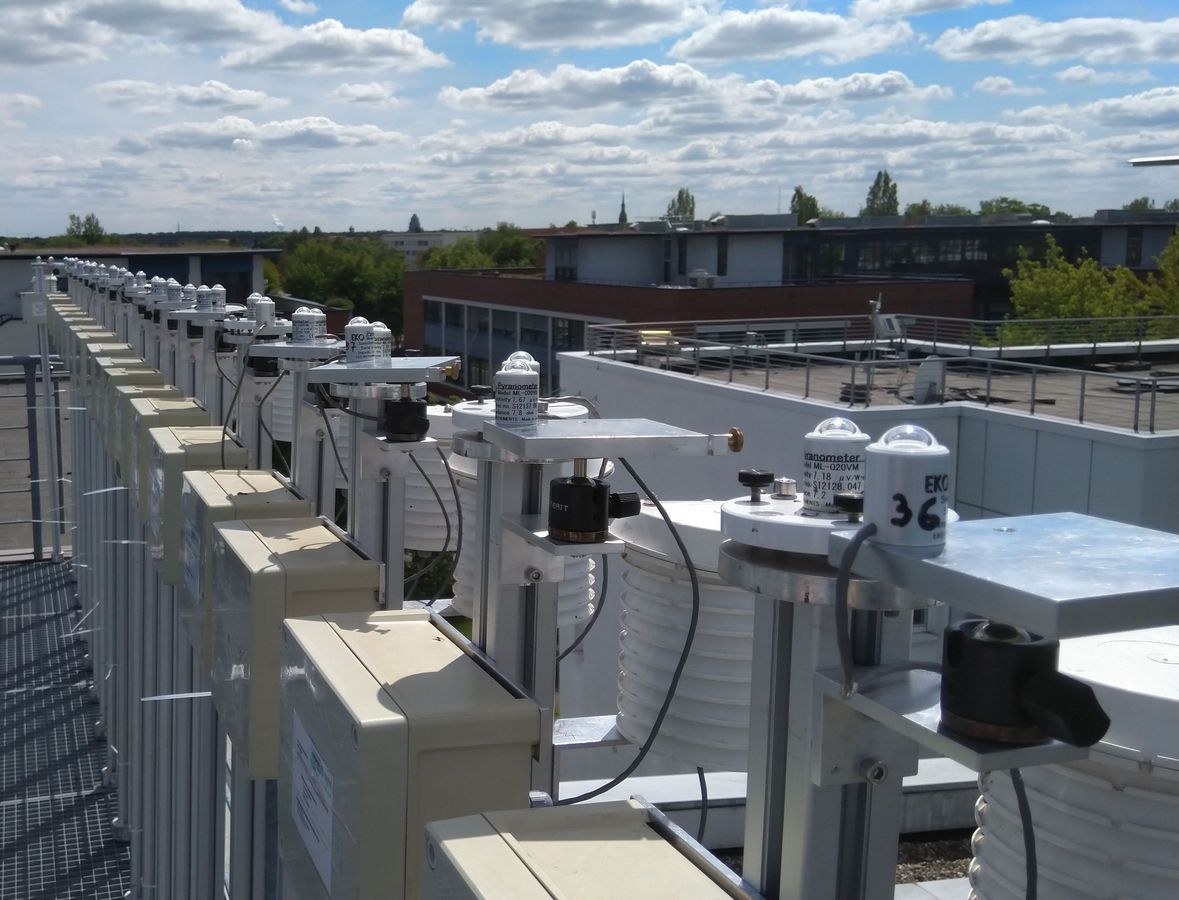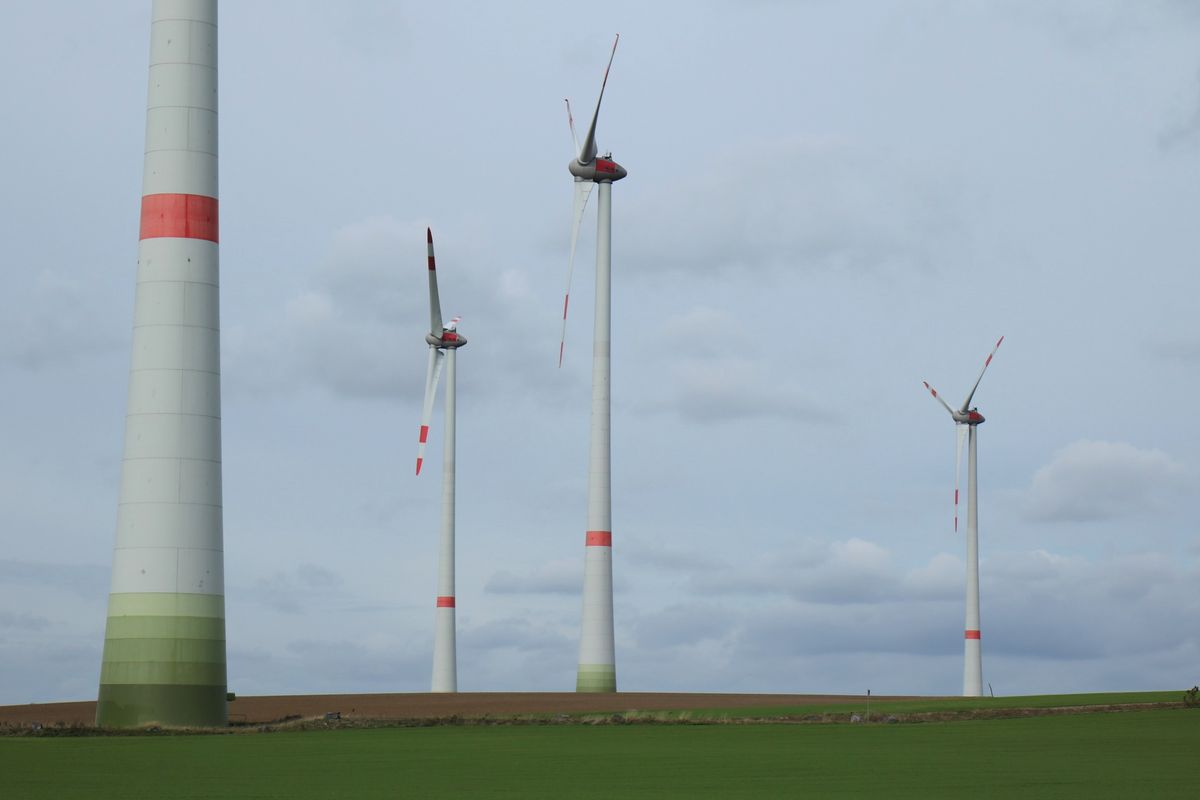Research in the Aerosols and Clouds Working Group focuses on the study of the interaction of aerosols and clouds in the atmosphere. Only a few observational studies have addressed this topic. With our research projects, we would like to close this gap and investigate the climate impact of air traffic in view of the ever-increasing number of flights and mankind's urge for global mobility.
Current Research Projects
Properties of In-cirrus Contrails from Airborne Remote-sensing Data (PICARD)
Funding: German Research Foundation
Period: 01/10/2023 – 30/09/2026

Aviation affects the Earth's energy balance through the emission of exhaust gases and a variety of non-CO2 effects of which linear contrails are the best known. Contrails form from aircraft effluent, can develop into widespread and persistent contrail cirrus, and affect the occurrence rate of cirrus. While optically thick cirrus can have a net cooling effect on the atmosphere, optically thin cirrus generally causes warming. Aircraft emissions and contrails can lead to optically thin and thick cirrus. Aircraft that fly through already existing cirrus can lead to contrails that are embedded in those clouds. Such embedded contrails could alter cirrus properties to a degree that inverts its climate effect from net warming to net cooling. Today, the effect of embedded contrails on the properties of already existing cirrus clouds is still virtually unstudied due to a lack of direct measurements and subsequent modelling studies. Only two observational studies have looked at the issue. Tesche et al. (2016) used spaceborne lidar data to show that embedded contrails increase the optical thickness of pre-existing cirrus. Marjani et al. (2022) found that ice crystal number concentration increases in cirrus regions that are affected by passing aircraft from analysing combined lidar-radar retrievals for the cases of Tesche et al. (2016). PICARD will expand upon the earlier work by exploiting the higher spatio-temporal resolution and measurement sensitivity of airborne lidar and radar measurements compared to spaceborne observations with the same measurement techniques. Observations of cirrus clouds conducted during at least four measurement campaigns with the German research aircraft HALO in regions where aircraft are likely to pass through already existing cirrus clouds will be analysed for serendipitous observations of embedded contrails. Lidar measurements during the dedicated cirrus experiments ML-CIRRUS and CIRRUS HL will be used to develop, test, and verify a mask for detecting perturbations in cirrus clouds that can be related to the passage of individual aircraft. The mask will be applied to those observations as well as the combined lidar-radar observations during NARVAL 1 and NAWDEX. The thus compiled data set will be used to quantify the effect of embedded contrails on the optical (lidar) and microphysical (lidar-radar) properties of pre-existing cirrus by relating changes in identified features to the unperturbed cloud. The data base of embedded contrails in HALO measurements will be used to establish a reference data set for the high-resolution modelling of embedded contrails, which is still in its infancy. The research proposed here is therefore vital in bounding the climate effect of aviation in light of steadily increasing flight numbers and mankind’s urge for global mobility.
Advancing mEasures to Reduce aviatiOn imPact on cLimate and enhAnce resilieNce to climate-changE (AEROPLANE))
Funding: European Union
Period: 01/09/2023 – 31/05/2025
Team: Dr. Matthias Tesche, Dr. Torsten Seelig
The interconnection between Aviation and climate is very tight. On the one hand, air traffic contributes to greenhouse gas emissions that alter the composition of the atmosphere globally, hence driving Climate Change. On the other hand, atmospheric processes significantly impact the whole chain of Aviation: changes in temperature affect infrastructure and aircraft performance, variable wind and precipitation patterns increase delays and cancellations, etc. In recent years, researchers put a strong effort in investigating the impact of Aviation on climate and ways to mitigate it. Putting these knowledge advancements into practice requires further development of the climate impact assessment methodology towards the deployment and implementation phases. In addition to these efforts, new adaptation measures are necessary to make the aviation sector less vulnerable to the unavoidable changes in climate conditions which we are already experiencing, such as heatwaves and other highly-impactful weather phenomena. Objectives: The project aims at developing a toolset for reducing the aviation impact on climate and to enhance the sector’s resilience to climate change. The idea is to advance the knowledge and operationalize the monitoring on the impact of aviation on climate, and, concurrently, to assess the resilience of the aviation sector to the exacerbation of extreme events due to climate change.
Improving the power forecast of photovoltaic systems to support the energy transition and to investigate aerosol-cloud interactions
Project period: 01.01.2023 – 31.12.2024
Funding: European Social Fund Plus (ESF Plus)
Team:
- Junior scientists: Fani Alexandri, Felix Müller, Teresa Vogl, Dr. Jonas Witthuhn
- Project lead: Jun.-Prof Heike Kalesse-Los, Dr. Matthias Tesche
- Participating scientists: Dr. Michael Schäfer, Dr. Andreas Foth, Prof. Dr. Johannes Quaas, Prof. Dr. Manfred Wendisch
Cooperation partner:
- Dr. Hartwig Deneke (Leibniz Institute for Tropospheric Research)

Ground-based and spaceborne remote sensing of the atmosphere is used for applied research on radiation, aerosols, clouds, and their interactions. It also provides important information for forecasting the generation of renewable energy. The type of cloud cover modulates the amount of solar radiation reaching the ground and thus influences the power generated by photovoltaic (PV) systems. Situations with broken cloud cover pose particular challenges. The causes are the extremely high variability of solar radiation, radiation reflected at cloud edges, and the influence of aerosol particles near clouds. By means of high temporal resolution solar radiation measurements with a spatially distributed pyranometer network, the radiation variability can be characterised for different amount of cloudiness and, in particular, for broken cloud cover. Such insights are significant for the planning and dimensioning of PV sites and power grids, and additionally provide scientifically relevant insights into aerosol-cloud interactions.
The high temporal and spatial resolution of today’s satellite observations enables unprecedented work on studying the behaviour of cloud properties over the life cycle of individual clouds, as well as the influence of aerosol particles on the properties of these tracked clouds.
Multilayer Arctic mixed phase clouds
Funding: Federal Ministry of Education and Research
Arctic clouds with their warm cloud tops (compared to the surface) can have a warming effect on the atmosphere. So far, studies of Arctic clouds have focussed on single-layer clouds, which form at boundary layer top. The radiative effect of clouds that occur at multiple heights simultaneously (multi-layer clouds) can be very different from that of single-layer clouds. This is because of
(i) more complex radiative transport,
(ii) adiabatic cooling of lower clouds, and
(iii) glaciation of lower clouds as a result of ice-crystal seeding from upper cloud layers.
MAMiP will address gaps in our scientific understanding of Arctic multi-layer clouds through four questions:
- What is the occurrence rate of Arctic multi-layer clouds compared to single-layer clouds?
- What is the occurrence rate of ice-crystal seeding in Arctic multi-layer clouds?
- Can simulations of Arctic multi-layer clouds with cloud-resolving models reproduce observations and provide insight into the dominating processes?
- Which factors determine ice-crystal seeding? What happens to seeded clouds?
- What is the role of multi-layer clouds in the Arctic amplification of global climate change?
Subproject: MAMiP:O - Observations of Arctic mixed phase clouds
Period: 01.07.2021 – 30.06.2024
Team: Dr. Peggy Achtert, Sajedeh Marjani, Dr. Matthias Tesche
The working group analyses the observations beyond the MOSAiC data set.
Subproject: MAMiP:M
Team: Working group Cloud Physics at Karlsruhe Institut of Technology
The observed cases will be simulated with a cloud-resolving model to investigate the connection between radiative and microphysical processes, the predictability of multi-layer clouds, and their effect on the radiative budget at the surface.
Finished Research projects
Particles in Aerosol Cloud Interactions: Stratification, CCN/INP concentration and Could Lifecycle (PACIFIC)
The clock is ticking – the aims of the Paris Climate Agreement have made clear what needs to change. But many aspects of the climate change are still unexplored. With the new programme international researchers are now given the opportunity to explore these questions from the fields of climate change, energy transition and earth system research at German universities and research institutions.
The programme, designed by the Federal German Ministry of Education and Research (BMBF) and implemented by the German Academich Exchange Service (DAAD), traces back to the „Make Our Planet Great Again" initiative taken by the French president Emmanuel Macron. With their commitment both countries support the aims of the Paris Climate Agreement which are recognized as an urgent global challenge. The projects are carried out between the 1st May 2018 and the 31st December 2022. In this period the research groups can dispose of a budget of up to 1 Mio. EUR (Junior Researcher) or 1.5 Mio. EUR (Senior Researcher).
Period: 01.01.2019 – 31.12.2022
Team: Fani Alexandri, Dr. Peter Bräuer, Goutam Choudhury, Dr. Torsten Seelig, Felix Müller, Dr. Matthias Tesche, Dr. Diego Santiago Villanueva Ortiz, Sabine Doktorowski
Atmospheric aerosol particles are of great importance for cloud formation in the atmosphere because they are needed to act as cloud condensation nuclei (CCN) in liquid-water clouds and as ice nucleating particles (INP) in ice-containing clouds. Changes in aerosol concentration affect the albedo, development, phase, lifetime and rain rate of clouds. These aerosol-cloud interactions (ACI) and the resulting climate effects have been in the focus of atmospheric research for several decades. Nevertheless, the IPCC still concludes that ACI cause the largest uncertainty in assessing climate change as they are understood only with medium confidence.
PACIFIC will improve our understanding of ACI (1) by enhancing the representation of the aerosols relevant for cloud processes and (2) by quantifying temporal changes in cloud properties throughout the cloud life cycle. ACI studies using polar-orbiting sensors are limited to snap-shot observations of clouds. CCN concentrations for assessing ACI are currently estimated from column- integrated optical aerosol parameters. There is no such proxy of INP concentrations for remote-sensing studies of aerosol effects on cold clouds as INP activity depends on aerosol type and size. Quantifying the role of aerosols in ACI requires knowledge of the spatial and vertical distribution of CCN and INP. I will use my experience in advancing state-of-the-art lidar retrievals to obtain unprecedented insight in CCN and INP concentrations from spaceborne lidar data. In addition, I will characterise the development of clouds before and after the snap-shot view of polar-orbiting sensors by tracking those clouds in time-resolved geostationary observations. This novel information will be used to study the effects of CCN and INP on the albedo, liquid and ice water content, droplet and crystal size, development, phase and rain rate of clouds within different regimes carefully accounting for the meteorological background. The findings of PACIFIC are crucial for assessing and improving the performance of climate models.


